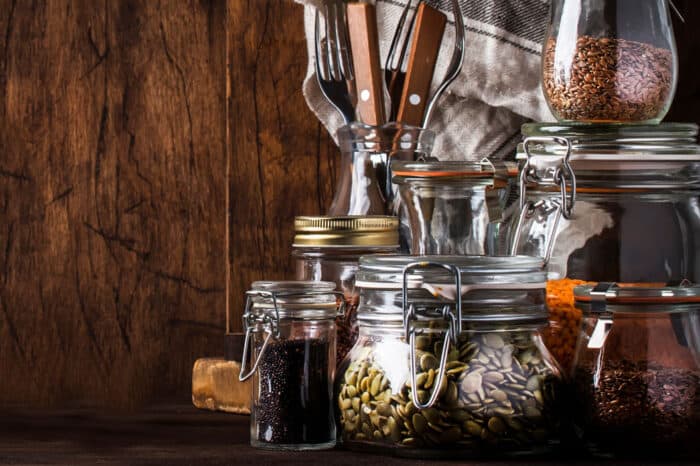
Written By: Owennie Lee, RD
Title: Registered Dietitian
Alumni: University of British Columbia
Last Updated on:

We have all been told to eat more nuts and seeds because of their plant-based protein, fiber, and healthy fats. Incorporating seeds into one’s diet might take a bit more pre-planning than nuts, as they are tiny and not easy to eat with hands. While some can be eaten as a snack on their own, others are best eaten with other foods. We’ve analyzed the nutritional values of 6 common edible seeds and compared their nutrition facts in a chart.

Table of Contents
| Per Tablespoon | Calories (kcal) | Protein (g) | Total Fat (g) | Alpha-Linolenic Acid (ALA) (g) | Fiber (g) | Calcium (mg) |
|---|---|---|---|---|---|---|
| Chia (10 g) | 49 | 1.6 | 3.4 | 1.8 | 3.8 | 63 |
| Flax (7 g) | 37 | 1.3 | 3.0 | 1.6 | 1.9 | 18 |
| Sunflower (9 g) | 53 | 1.0 | 4.6 | 0.01 | 0.78 | 7 |
| Hemp (16.5 g) | 80 | 5.5 | 4.9 | n/a | 0.5 | 0 |
| Pumpkin (8 g) | 43 | 2.0 | 3.7 | 0.15 | 0.31 | 3.4 |
| Sesame (9 g) | 52 | 1.6 | 4.5 | 0.034 | 1.1 | 88 |
Chia is the new seed on the block. Arguably the most nutrient-dense of all seeds, chia is best known for its high contents of ALA (a type of omega-3 fatty acid), fiber, and calcium contents. It has been shown to help with blood sugar control and reduce cardiovascular disease risk in research. Chia is also the only seed that can double as a thickener when allowed to soak in water.
Flaxseeds have been highly sought after for at least a decade, also because of its high ALA and fiber contents. Research reveals that lignan (a type of phytoestrogen) in flaxseeds shows a lot of promise in fighting diseases. Unlike chia seeds, flaxseeds have to be ground for nutrients to be better absorbed.
Sellers of hemp seeds may want you to believe that hemp is a cure-all for all ailments, but the evidence is scant. Hemp contains gamma-linolenic acid (GLA), a kind of fatty acid that exhibits some anti-inflammatory properties, but study results of its effect on preventing inflammation have been inconclusive. Nevertheless, hemp seed is still a good source of plant-based protein and can be part of a healthy diet.
Pumpkin seeds are also known as pepitas. This mildly nutty seed is a good source of protein and phytosterols, which can help lower blood cholesterol levels. Snacking on pumpkin seeds also provides you with good levels of magnesium, manganese, and phosphorus.
Sesame seeds are commonly found on top of buns, added to dishes, made into sesame snaps, or used to make the fragrant sesame oil, but rarely eaten as a snack. These tiny white seeds are surprisingly big in nutrition. Not only are they an excellent source of plant-based calcium and a good source of fiber, they are also rich in lignan and the richest source of phytosterols of all nuts and seeds eaten.
Sunflower seeds are an exceptionally good source of Vitamin E, which helps to protect the brain from oxidative damage. They are also high in magnesium, a mineral that has been shown to be helpful in the prevention of migraine headaches. Sunflower seeds are also phytosterol-rich and can be part of a cholesterol-lowering diet.
Seeds are highly nutrient-dense and are very versatile. Include more seeds to up your nutrition by snacking on them (sunflower seeds and pumpkin seeds), or adding them to trail mixes, yogurt or salads, breakfast cereals, and breads – the possibilities are endless!
Alumni: University of British Columbia – Owennie is a registered dietitian with a soft spot for chocolate and coffee. She is a believer in balance and moderation, and is committed to keeping healthy eating enjoyable and fun. Owennie received her dietetics training in Vancouver, and is a member of Dietitians of Canada and the College of Dietitians of British Columbia. She has experience in a wide variety of settings, such as clinical nutrition, long-term care and outpatient counseling. Owennie has also worked for a community nutrition hotline and participated regularly as a guest radio host, where she enjoyed sharing her passion and knowledge about food and nutrition with people.
chia seeds, flaxseeds, hemp hearts, nutritional values, omega-3, pumpkin seeds, seeds, seeds nutrition chart, seeds nutrition facts, sesame seeds, sunflower seeds
Why on earth would you put different weights of the seeds in the comparison and not standardize it??
Hi John,
The table you are referring to is clearly marked to display items as per 1 tablespoon. I hope that makes more sense.
Ian
I agree with the commenter above that while we might typically measure out these foods with a tablespoon, in order to accurately compare their nutritional composition the amount of each nutrient in identical masses of each seed would be far more valuable. As shown, it isn’t really possible to say which seed is the best source of any of the nutrients without doing some math.